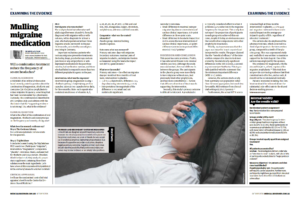Journal reference: Gaul C, Diener HC, Danesch U, Migravent Study G. Improvement of migraine symptoms with a proprietary supplement containing riboflavin, magnesium and Q10: a randomized, placebo-controlled, double-blind, multicenter trial. J Headache Pain 2015;16:516.
Link: https://dx.doi.org/10.1186/s10194-015-0516-6
Published: April 2015
 Evidence cookie says… |
The evidence for combination magnesium, riboflavin, and CoQ10 is at best equivocal for migraine prophylaxis
|
 The article was published in the October 2018 issue of Medical Observer, under the title “Mulling migraine medication”.
The article was published in the October 2018 issue of Medical Observer, under the title “Mulling migraine medication”.
Clinical scenario
On an online GP discussion board, a member recently posted a question about the combination of magnesium, riboflavin, and coenzyme q10 (CoQ10) as prophylaxis to reduce migraine frequency, something that had been recommended by a pharmacist. Curiously, this combination is described in eTG Complete (July 2018 edition) with the disclaimer that the “supporting evidence is not strong”. So, what is the evidence?
Clinical question
What is the effect of the combination of oral magnesium, riboflavin, and coenzyme Q10 on the frequency and severity of migraine?
What does the research evidence say?
Step 1: The Cochrane Library
No Cochrane systematic review exists for the question.
Step 2: TripDatabase
I conducted a search initially using the TripDatabase PICO search tool (Participant: “migraine”, Intervention: “magnesium”, Comparator: “placebo”, Outcomes: blank), and searched for riboflavin and CoQ10 in turn. This identified the Gaul et al. (2015) study of a proprietary supplement containing these three substances as the main ingredients. Let’s have a look at this randomised trial published in the Journal of Headache and Pain in detail [1].
Critical appraisal
I will use the randomised controlled trial appraisal sheet from the Centre for Evidence Based Medicine [2].
PICO
Participants: who was studied?
130 otherwise well adults (aged 18-65 years), formally diagnosed with migraine with or without aura, with a diagnosis for at least a year, who had experienced at least 3 migraine attacks per month in the last 3 months, recruited by neurologists practicing in Germany.
Important exclusions: patients who took any migraine preventive treatments (including drugs, psychotherapy, and acupuncture), any antipsychotic or antidepressant medication in the past 3 months, had medication overuse, and those who had failed to respond to more than 2 different prophylactic agents in the past.
Intervention: what was the exposure?
intervention group: magnesium 600 mg + riboflavin 400 mg + CoQ10 150 mg per 4 capsules, taken as 2 capsules twice daily, for 3 months
Note: each capsule also contained small doses of vitamins A, C, E, B1, B3, B5, B6, B7, B12, D, folic acid, and iron, zinc, manganese, copper, chromium, molybdenum, selenium, and bioflavonoids.
Comparator: what was the control/alternative?
placebo group: identical looking placebo capsules
Outcomes: what was measured?
Primary outcome: days with migraine
Secondary outcomes: maximal pain of migraine headache, and migraine burden as measured using the headache impact test (HIT-6) questionnaire [3]
Internal validity: are the trial results valid?
Randomised patient assignment?
Yes. Randomisation lists were prepared by computer.
Groups similar at the start?
Arguably not. The placebo group (vs intervention group) had more migraine without aura (64.9% vs 50.9%), fewer participants on no previous prophylactics (63.2% vs 72.7%), with more history of medical disease (57.8% vs 42.1%) and concomitant medications (63.6% vs 36.3%).
Groups treated equally apart from assigned treatment?
Yes.
All patients accounted for?
Unclear. The investigators did not undertake an “intention-to-treat” analysis, with approximately 14% of participants excluded due to “major protocol violation”.
Measures objective? Or patients and clinicians kept blinded?
Possibly/probably not. Participants self-reports can be subjective. Furthermore, participants might have guessed their allocated treatment due to the effect of riboflavin on urine colour.
What were the results?
Primary outcomes – the effect on migraine days per month at 3 months of treatment, intervention vs placebo:
- -1.8 vs -1.3 days/month, difference = 0.5 days (favouring intervention), p = 0.23
- Interpretation: the magnitude of the difference is very small and not statistically significant
Secondary outcomes:
- Small difference in maximal pain per migraine day (favours intervention) of unclear clinical importance, 0.17-point difference on 3-point scale
- Small difference in headache impact test (HIT-6 score) (favours intervention) of unclear clinical importance, 2.8-point difference (minimum important difference is 2.3 to 2.7 points). [4]
Discussion and conclusion
This paper has some problems. Firstly, it has substantial threats to its internal validity. Although the study was randomised, there are differences between the groups. The participants in the placebo group were more likely to have migraine without aura, had previously tried other prophylaxis, and had more comorbidities – factors that all have a direction of bias towards supporting the intervention.
Secondly, this study’s primary outcome is difficult to interpret. A prophylactic is typically considered effective when it achieves a 50% reduction in the migraine frequency for the patient. This study does not report the proportion of participants in each group who achieved this outcome, despite it being an obvious measure that would allow comparisons with other prophylactic treatments.
Thirdly, my impression was that this paper was biased in how it reported and interpreted its results. The paper claimed that the “beneficial efficacy” of the intervention compared to placebo is demonstrated by the statistically significant differences in the HIT-6 scores, a secondary outcome (see StatFacts). This is partially justified with the statement that the minimum important difference (MID) is 1.5 points. However, the authors cited a study from a primary care population [5], rather than the more appropriate, but much less favourable, MID estimate from clinical trial settings (2.3 to 2.7 points) [4]. Furthermore, the actual HIT-6 scores remained high at 3-months (intervention vs placebo, 57.1 vs 59.9) – migraine continued to have a substantial impact on the average participant’s quality of life regardless of allocated treatment [6]. The authors also deemphasised the adverse event rate, which occurred in a third of participants in the intervention group, compared to a tenth of the placebo group. This was a sponsored study and reads like it was written to maximise support for the tested agent. Indeed, one of the authors was explicitly employed by the sponsor.
The evidence for magnesium, riboflavin, and CoQ10 is at best equivocal for migraine prophylaxis [7-11]. This trial does not provide convincing evidence that their combination is effective, and as such, it should not be recommended routinely. Patients interested in taking this combination should be informed about the substantial side-effect rate in the shared-decision making process.
Stat Facts
Primary and secondary outcome measures
Clinical trials are designed around the primary outcome measure. In critical appraisal, focus needs to be placed on the primary outcomes. As a rule of thumb, be very sceptical of predictive empirical claims that a hypothesis is true because of supportive secondary outcomes, despite a negative primary outcome. Negative primary outcomes should raise the possibility that positive secondary outcomes may be due to biases or are simply false positives.
References
- Gaul C, Diener HC, Danesch U, Migravent Study G. Improvement of migraine symptoms with a proprietary supplement containing riboflavin, magnesium and Q10: a randomized, placebo-controlled, double-blind, multicenter trial. J Headache Pain 2015;16:516.
- Centre for Evidence-Based Medicine. Critical Appraisal tools. 2014 [cited 2018 September 24]; Available from: http://www.cebm.net/critical-appraisal/
- Kosinski M, Bayliss MS, Bjorner JB, et al. A six-item short-form survey for measuring headache impact: the HIT-6. Qual Life Res 2003 Dec;12(8):963-74.
- Coeytaux RR, Kaufman JS, Chao R, Mann JD, Devellis RF. Four methods of estimating the minimal important difference score were compared to establish a clinically significant change in Headache Impact Test. J Clin Epidemiol 2006 Apr;59(4):374-80.
- Smelt AF, Assendelft WJ, Terwee CB, Ferrari MD, Blom JW. What is a clinically relevant change on the HIT-6 questionnaire? An estimation in a primary-care population of migraine patients. Cephalalgia 2014 Jan;34(1):29-36.
- Yang M, Rendas-Baum R, Varon SF, Kosinski M. Validation of the Headache Impact Test (HIT-6) across episodic and chronic migraine. Cephalalgia 2011 Feb;31(3):357-67.
- Pfaffenrath V, Wessely P, Meyer C, et al. Magnesium in the prophylaxis of migraine–a double-blind placebo-controlled study. Cephalalgia 1996 Oct;16(6):436-40.
- Wang F, Van Den Eeden SK, Ackerson LM, Salk SE, Reince RH, Elin RJ. Oral magnesium oxide prophylaxis of frequent migrainous headache in children: a randomized, double-blind, placebo-controlled trial. Headache 2003 Jun;43(6):601-10.
- Maizels M, Blumenfeld A, Burchette R. A combination of riboflavin, magnesium, and feverfew for migraine prophylaxis: a randomized trial. Headache 2004 Oct;44(9):885-90.
- Counts DN. Riboflavin as Migraine Prophylaxis in Children and Adolescents: A Systematic Review of the Literature. Oregan: Pacific University; 2011.
- Slater SK, Nelson TD, Kabbouche MA, et al. A randomized, double-blinded, placebo-controlled, crossover, add-on study of CoEnzyme Q10 in the prevention of pediatric and adolescent migraine. Cephalalgia 2011 Jun;31(8):897-905.

Recent Comments